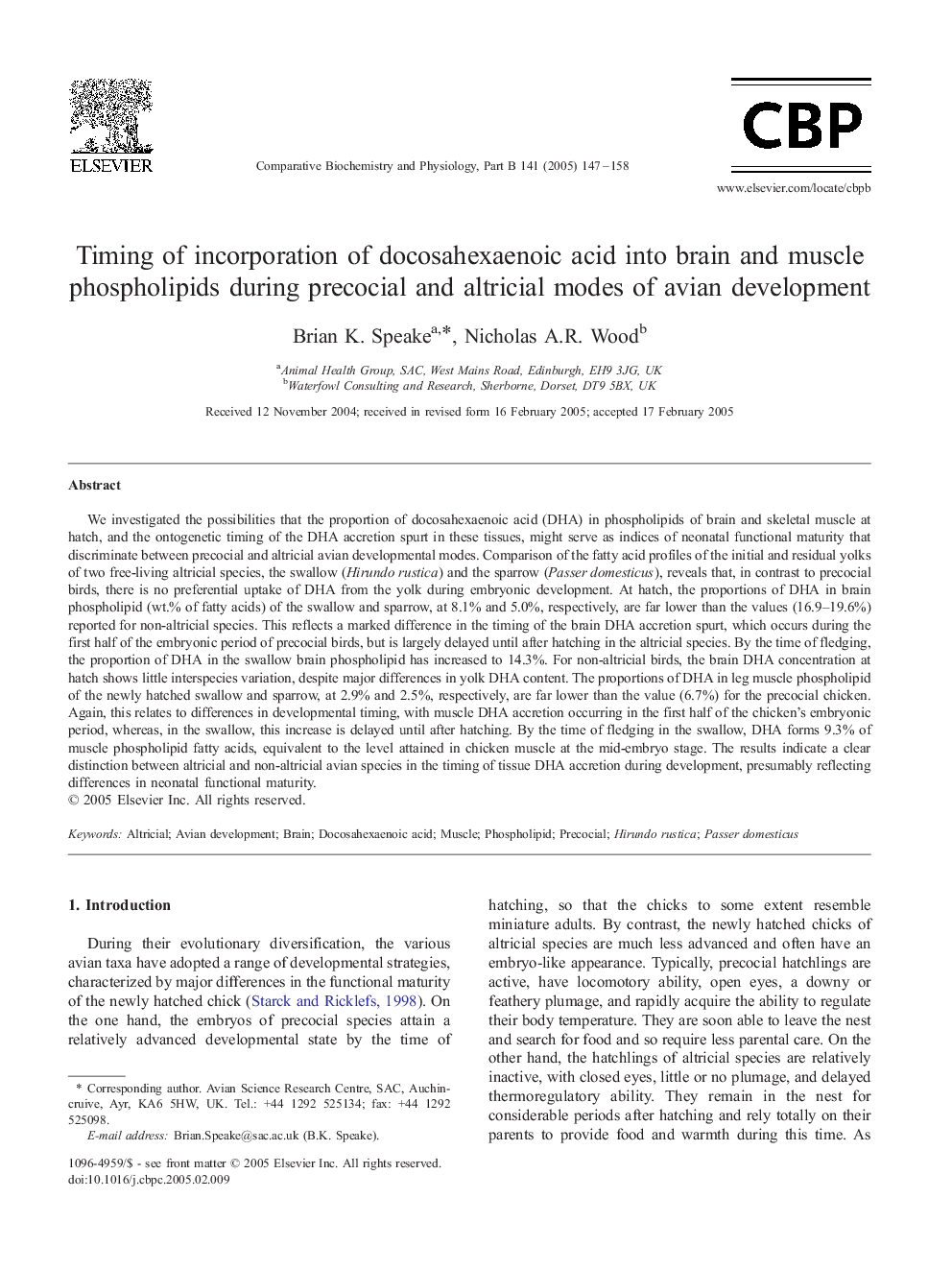| کد مقاله | کد نشریه | سال انتشار | مقاله انگلیسی | نسخه تمام متن |
|---|---|---|---|---|
| 10820510 | 1060709 | 2005 | 12 صفحه PDF | دانلود رایگان |
عنوان انگلیسی مقاله ISI
Timing of incorporation of docosahexaenoic acid into brain and muscle phospholipids during precocial and altricial modes of avian development
دانلود مقاله + سفارش ترجمه
دانلود مقاله ISI انگلیسی
رایگان برای ایرانیان
کلمات کلیدی
موضوعات مرتبط
علوم زیستی و بیوفناوری
بیوشیمی، ژنتیک و زیست شناسی مولکولی
زیست شیمی
پیش نمایش صفحه اول مقاله

چکیده انگلیسی
We investigated the possibilities that the proportion of docosahexaenoic acid (DHA) in phospholipids of brain and skeletal muscle at hatch, and the ontogenetic timing of the DHA accretion spurt in these tissues, might serve as indices of neonatal functional maturity that discriminate between precocial and altricial avian developmental modes. Comparison of the fatty acid profiles of the initial and residual yolks of two free-living altricial species, the swallow (Hirundo rustica) and the sparrow (Passer domesticus), reveals that, in contrast to precocial birds, there is no preferential uptake of DHA from the yolk during embryonic development. At hatch, the proportions of DHA in brain phospholipid (wt.% of fatty acids) of the swallow and sparrow, at 8.1% and 5.0%, respectively, are far lower than the values (16.9-19.6%) reported for non-altricial species. This reflects a marked difference in the timing of the brain DHA accretion spurt, which occurs during the first half of the embryonic period of precocial birds, but is largely delayed until after hatching in the altricial species. By the time of fledging, the proportion of DHA in the swallow brain phospholipid has increased to 14.3%. For non-altricial birds, the brain DHA concentration at hatch shows little interspecies variation, despite major differences in yolk DHA content. The proportions of DHA in leg muscle phospholipid of the newly hatched swallow and sparrow, at 2.9% and 2.5%, respectively, are far lower than the value (6.7%) for the precocial chicken. Again, this relates to differences in developmental timing, with muscle DHA accretion occurring in the first half of the chicken's embryonic period, whereas, in the swallow, this increase is delayed until after hatching. By the time of fledging in the swallow, DHA forms 9.3% of muscle phospholipid fatty acids, equivalent to the level attained in chicken muscle at the mid-embryo stage. The results indicate a clear distinction between altricial and non-altricial avian species in the timing of tissue DHA accretion during development, presumably reflecting differences in neonatal functional maturity.
ناشر
Database: Elsevier - ScienceDirect (ساینس دایرکت)
Journal: Comparative Biochemistry and Physiology Part B: Biochemistry and Molecular Biology - Volume 141, Issue 2, June 2005, Pages 147-158
Journal: Comparative Biochemistry and Physiology Part B: Biochemistry and Molecular Biology - Volume 141, Issue 2, June 2005, Pages 147-158
نویسندگان
Brian K. Speake, Nicholas A.R. Wood,